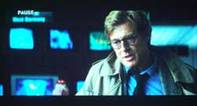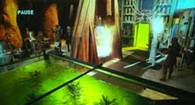InFocus ScreenPlay 5000 LCD Projector Review
- Product Name: ScreenPlay 5000 LCD Projector
- Manufacturer: InFocus
- Performance Rating:




- Value Rating:




- Review Date: September 02, 2005 19:00
- MSRP: $ 1499
|
Device: Three 0.7" TFT Active Matrix Panels Native
Resolution: 1280 x 720
pixels (16:9) Throw: 1.65:1 -
1.98:1 (distance/width) Accessories Included: Power cord, remote, s-video cable, A/V cable, computer cable, User Guide, quick start card |
Video
Inputs: DVI/M1 (w/HDCP),
Component, HD15 (VESA), S-video, composite Fan
Noise: 58db (measured
at source) |
Pros
- Excellent color detail
- This projector is a TORCH and can play visible content in a fully-lit room
- Backlit remote control
- Direct access to inputs from remote
- Automatic Vertical Keystoning is nifty
Cons
- Fan noise (~58db at the source)
- Manual zoom & focus
- Needs long throw distance or smaller screen for best picture
- No lens shift
- Poor deinterlacing
InFocus ScreenPlay 5000 Introduction
Many people ask me about projector choices, but few have a light-controlled room in which to arrange many of the units I recommend. Last season I threw a rather large Superbowl Party and became quickly aware that there is a place in the world of home theater for bright projection systems - even at the sacrifice of black level and contrast. At the time I had used an LCoS projector that did a pretty good job of getting the picture onto the 100" screen from across the room. It was bright enough so that I could have guests watch the game without putting them in darkness. In fact, I was able to keep all of the lights on and allow unmitigated access to the central food and drink area in the same room. The ScreenPlay 5000, in comparison to that unit, is a veritable 'torch'. The amount of light this little projector throws is nothing short of astounding and I believe I have found a nice compromise to the needs of many people interested in adding a front projection system to their home.
Features and Favorites
The InFocus ScreenPlay 5000 comes with some useful features that really stood out to me. Here are some of our favorites:
-
Lightweight and Portable
With an included VESA HD15 input for computer use and a weight and size that make portability a reality, not just an advertised feature, the ScreenPlay 5000 truly meets the dual-use needs of a theater projector that can do double-duty in the boardroom. -
1100 ANSI Brightness
1100 ANSI lumens means that you can show films or television content with some ambient light in the room, especially if you are projecting onto a 100" screen or less. I have seen projectors rated at more lumens that did not put out the light of the ScreenPlay 5000. If you are looking for something to allow sporting events to be played in a medium-lit room, this will do just fine. -
Ample Color Controls
By providing controls for RGB Gain, Offset and Gamma, InFocus gives users a fighting chance to get a really good calibration out of this projector in a myriad of lighting environments. In contrast to normal practice, I performed all calibrations and adjustments with ambient light so that I could see how well the system would perform in that environment.
InFocus ScreenPlay 5000 Setup
Basic Setup and Installation
As always, when setting up a projection system you'll want to consider your mounting options, whether you want to hang it from a ceiling or perhaps set it on a table. The ScreenPlay likes to be mounted a couple of feet below the bottom of the screen when situated on a table. This will subsequently allow you to ceiling mount it in mos t rooms that can situate top of the screen a couple feet from the top of the room. Once placed it sets up easily out of the box and only requires power and input to get going.
To level out the projector you can use the front elevator foot and side rotating foot to get the image as perfectly squared to the projection screen as possible. To use the front foot, simply depress the button on the top side of the projector and it will free it to move up and down. I recommend making as many physical adjustments as possible before utilizing the digital keystone correction. In all honestly, you will want a professional to aid in the installation if you are ceiling mounting this unit due to the accuracy that must be obtained in order to fit the picture squarely to the screen. If you want to use the keystone feature, the ScreenPlay 5000 has a neat twist. There is an Auto Vertical keystone setting that uses a sensor to determine the best vertical keystone setting to make sure the image is perfectly squared to the screen. The same sensor can also be used to automatically set the projector if it's going to be ceiling mounted. If you do turn on Auto Vertical keystone, be aware that it will pop up a window on the bottom left of the screen in an attempt to make a correction if you bump the projector even a tiny bit (and though we never recommend its use if you wish to attain the most sharp image possible, auto-keystoning the picture is fun to show your friends and an excellent feature for boardroom use!)
 Once the projector is turned on we did notice that there was a
significant amount of light leakage from the back and side panels. This
picture was taken with a long exposure to help show the lighted areas,
so don't think that light is literally beaming out of the sides. It
does, however come through the unused rear connectors and on both
vented sides. Many modern home theater projectors control light
emissions so that nothing adds to the minimum output of the projector
and absolutely black areas on the screen can remain as dark as
possible.
Once the projector is turned on we did notice that there was a
significant amount of light leakage from the back and side panels. This
picture was taken with a long exposure to help show the lighted areas,
so don't think that light is literally beaming out of the sides. It
does, however come through the unused rear connectors and on both
vented sides. Many modern home theater projectors control light
emissions so that nothing adds to the minimum output of the projector
and absolutely black areas on the screen can remain as dark as
possible.
Throw Distance and Projection Screen Sizing
We used a Stewart Studiotek 130 100" screen for this review, though I would have liked a smaller screen for the room. There is a manual zoom, allowing you a bit of play on distance, but this projector requires a somewhat long throw distance to realize it's potential. You will also want to sit well behind the projector to watch movies so take this into account when you plan your room and seating. Here's how the InFocus ScreenPlay 5000's default lens sizes up against various screen sizes:
|
Screen Size (Diagonal) |
Projection Distance (Wide ~ Tele) |
|---|---|
|
40" (101.6cm) |
5.0' ~ 5.7' |
|
60" (152.4cm) |
7.2' ~ 8.6' |
|
80" (203.2cm) |
9.6' ~ 11.5' |
|
100" (254.0cm) |
12.0' ~ 14.4' |
|
120" (304.8cm) |
14.4' ~ 17.3' |
|
140" (355.6cm) |
16.8' ~ 20.1' |
As you can see, with our viewing size of 100" diagonal we were putting the projector back about 12-14' to fill our screen. This is likely not an issue if you plan on installing this projector on a ceiling - however it is something that should be noted. There is a noticeable screen door pattern on this (or any 720p LCD projector) if you are seated too close to the screen. I recommend trying to situate yourself behind the projector or site at least 2x-2.5x the screen width back from the screen. If you are watching this on a 100" diagonal screen, this means you'll want to sit about 14.5' back from the screen.
The ScreenPlay 5000 lacks any lens shift capability. This means you'll need to mount the projector exactly in the correct position for your room and screen size to avoid having to do keystone adjustments or having to angle the projector. While it does come with a fairly sophisticated digital keystone function (mentioned earlier), it should be avoided whenever possible as it softens the image - even if used just a little bit.
InFocus ScreenPlay 5000 Connections & Bench Tests
There are quite a few input options for the ScreenPlay 5000. It features M1, HD15 (VESA), component, composite and s-video connections. I would recommend this unit be used with either an M1 to HDMI/DVI adapter (not included) or the component video inputs. Of course if you are using this projector as a presentation device then the HD15 inputs are just fine. The M1 input is HDCP-compatible, however I hope this is the last ScreenPlay model InFocus sells that does not include at least one of the adapters. In this day and age it is inconceivable to let a projector out to market without direct HDMI or DVI input capability.
We utilized the component video inputs for our tests. We tried both interlaced and progressive source signals to check the deinterlacing ability of the ScreenPlay 5000. Our results are shown in the Viewing Evaluation setup
Remote Control
I'll just come out and say it - the remote for the ScreenPlay 5000 is actually quite good. Each
button has an amber backlight that can be activated by pressing a button on the side of the remote. In
addition, there are direct access buttons to each of the projector's inputs. The menu system is simple,
yet intuitive, and the oft-used "resize" button is easy to locate, being isolated from the other
controls. The remote fits well in the hand and I found that my thumb could access just about all of the
buttons without having to shift the remote in my palm.
A "blank" button is provided to temporarily hide the picture, however it is replaced by a blue screen so it is next to useless as a feature. An "auto image" button quickly resynchronizes the projector to the source. This is rarely needed, however, as the projector will auto-search for the next available input (this feature can be disabled in the menu system).
Advanced Setup and Calibration
In addition to Brightness and Contrast settings, the ScreenPlay 5000 allows user access to red, green and blue Gain, Offset, and Gamma. With these controls you can really dial in the calibration. I found the default settings to be at least in the ballpark, though you can certainly pay some attention to color temperature and the Green color adjustments to help tweak the Green decoder errors I found (football should look very good on this set). Overall, the system dialed in to an acceptable and pleasing appearance.
Audioholics/HQV Bench Testing Summary of Test Results
Perfect Score:
130
ScreenPlay 5000 Benchmark Score:
45
Recommendation: For optimal quality this projector should be mated with a good source component outputting 480p/720p/1080i
|
Test |
Max
|
SP5000
|
SP5000
|
|---|---|---|---|
|
Color Bar |
10 |
5 |
Pass |
|
Jaggies #1 |
5 |
0 |
Fail |
|
Jaggies #2 |
5 |
0 |
Fail |
|
Flag |
10 |
0 |
Fail |
|
Detail |
10 |
5 |
Pass |
|
Noise |
10 |
0 |
Fail |
|
M otion adaptive Noise Reduction |
10 |
0 |
Fail |
|
Film Detail |
10 |
10 |
Pass* |
|
Cadence 2:2 Video |
5 |
5 |
Pass |
|
Cadence 2:2:2:4 DV Cam |
5 |
5 |
Pass |
|
Cadence 2:3:3:2 DV Cam |
5 |
0 |
Fail |
|
Cadence 3:2:3:2:2 Vari-speed |
5 |
0 |
Fail |
|
Cadence 5:5 Animation |
5 |
5 |
Pass |
|
Cadence 6:4 Animation |
5 |
0 |
Fail |
|
Cadence 8:7 animation |
5 |
0 |
Fail |
|
Cadence 3:2 24fps film |
5 |
5 |
Pass |
|
Scrolling Horizontal |
10 |
5 |
Pass |
|
Scrolling Rolling |
10 |
0 |
Fail |
|
Total Points |
130 |
45 |
|
Comments on HQV Testing
As you can see from the results, the video processing on the ScreenPlay isn't much to write home about. While it performs 2:3 pulldown and does some deinterlacing it does so just enough to get by. The poor reduction of "jaggies" was the real killer and as a result we simply recommend pairing this projector with good quality source components. If you feed it a good source outputting 480p, 720p, or 1080i, then the ScreenPlay merely serves as a display - making poor deinterlacing irrelevant (it won't be doing any - just some scaling). Just to make sure it worked as intended, I paired the projector with a Denon DVD-3910 outputting 480p and the results were completely different. Hook it up via HDMI with a 720p source and you will likely get even nicer results.
ScreenPlay 5000 Viewing Evaluation and Conclusion
Viewing Evaluation - HDTV and Animated Movies
I wanted to see how well the ScreenPlay 5000 did in real world tests using ambient light. To experience it fully I turned on some Discovery HD material. Everyone who has an HDTV has watched the Discovery HD Channel - it's simply mesmerizing. I found that I was able to watch it without much trouble at all with plenty of ambient light in the room (in my case an overhead fan light and a couple large windows on the right wall of the room. Take a look at some of these pictures - taken while ambient light was present in the viewing room:

To say that this projector does not require a perfectly darkened room is an understatement. Don't let the 1100 ANSI lumens fool you. I have seen projectors rated much higher that didn't put out light like this. I also wanted to put on some animation footage which traditionally puts out more light and avoids the typical dark scenes you find frequenting film scenes. Using Star Wars: Clone Wars Volume One, all of the images improved greatly with a darkened room, of course. I did the rest of the viewing tests without ambient light so that those of you interested in the max potential of this projector could take a look at the image quality.
DVD: Spy Game
Spy Game is one of my favorite movies and there are plenty of
scenes within to show off skin detail and black levels. In particular,
there are some scenes with close-ups of Brad Pitt and Catheryn
McCormack that do well to show what this projector can show. 1280x720
pixels covers quite a bit of area and the results show up as a nice
seamless picture at the proper viewing distance. The movie's plot is
gradually revealed through the use of continuous flashbacks
interspersed with interior locations. During the interiors you get a
decent amount of shadowed areas which will still be hard to see with
ambient room light, but the outdoor scenes and the film in general
proved to result in a good viewing experience with the ScreenPlay 5000.

DVD: Farscape - The Peacekeeper Wars
Farscape's cinematography is as colorful as its sub-plots and
general story line. I am a huge fan of this show and can only say that
the Sci-Fi Channel demonstrated a tremendous abundance of cluelessness
in canceling the show a year earlier than anticipated. The result was a
year or so off, followed by a final 4-hour miniseries to wrap up the
show's remaining loose ends. The photos we captured here detail exactly
how spectacular the imagery of this series is. The ScreenPlay 5000 took
the colors in the miniseries and practically painted them on the
screen. The picture was incredibly vivid and I even flipped the lights
on to see that indeed you could watch a show like this with ambient
light present in the room. Flipping the lights back off, I couldn't
help but notice the clear detail that came through in both the costumes
and the prosthetics and aliens provided by Jim Hensen's Creature Shop.
The sets looked fantastic as well and when the movie was done I wanted
to go back and hunt out particular scenes just because they looked so
good on the screen.

Conclusion
I can't say it enough - the ScreenPlay 5000 is a torch. I have seen better black levels in a projector, but I have had to sacrifice ambient light capability every time. There are some improvements that could certainly be made in this unit to be sure. I'd love to see better containment of light from the projector so that leakage is not a problem. The fan could indeed be quieter and there really needs to be an M1 cable or adapter sold with each unit.
With all that said, the ScreenPlay 5000 is the perfect projector for someone looking for a hybrid use device that can handle Sunday afternoon football as well as night-time theatrical presentations in the home. I have run into a LOT of those kinds of people. In the past the stereotype has been that great sacrifices must be made in a projector in order to attain a brighter picture. While this is partially true, when done correctly, a device like this projector can make those sacrifices both minimal and acceptable. In this case, the gains far outweigh the losses.
InFocus ScreenPlay 5000
MSRP: $1,499
(888) 282-PLAY
http://www.infocushome.com/
About InFocus
Corporation
InFocus Corporation, the worldwide leader in digital projection
technology and solutions, enhances thinking, learning and creativity in boardrooms, meeting rooms and
classrooms and delivers superior home entertainment experiences by vividly projecting and displaying
larger-than-life images from multiple sources including computers, DVD players, and
PDAs.
From the smallest and lightest mobile projectors and feature-packed meeting room products to the finest home entertainment solutions, InFocus has garnered industry acclaim for design, functionality and intuitive solutions for its InFocus®, InFocus ScreenPlay®, LiteShow® and ASKProxima products.
The Score Card
The scoring below is based on each piece of equipment doing the duty it is designed for. The numbers are weighed heavily with respect to the individual cost of each unit, thus giving a rating roughly equal to:
Performance × Price Factor/Value = Rating
Audioholics.com note: The ratings indicated below are based on subjective listening and objective testing of the product in question. The rating scale is based on performance/value ratio. If you notice better performing products in future reviews that have lower numbers in certain areas, be aware that the value factor is most likely the culprit. Other Audioholics reviewers may rate products solely based on performance, and each reviewer has his/her own system for ratings.
Audioholics Rating Scale




 — Excellent
— Excellent



 — Very Good
— Very Good


 — Good
— Good

 — Fair
— Fair
 — Poor
— Poor
| Metric | Rating |
|---|---|
| Detail and Resolution | |
| Deinterlacing & Scaling | |
| Contrast and Black Levels | |
| Color Reproduction | |
| Noise Reduction | |
| Calibration Options | |
| Build Quality | |
| Ergonomics & Usability | |
| Ease of Setup | |
| Features | |
| Remote Control | |
| Performance | |
| Value |








